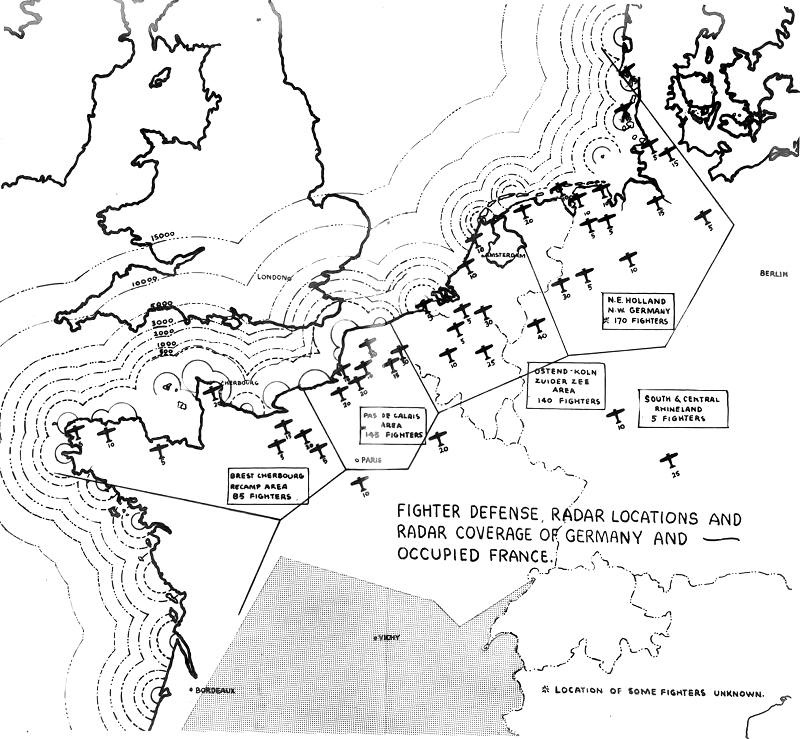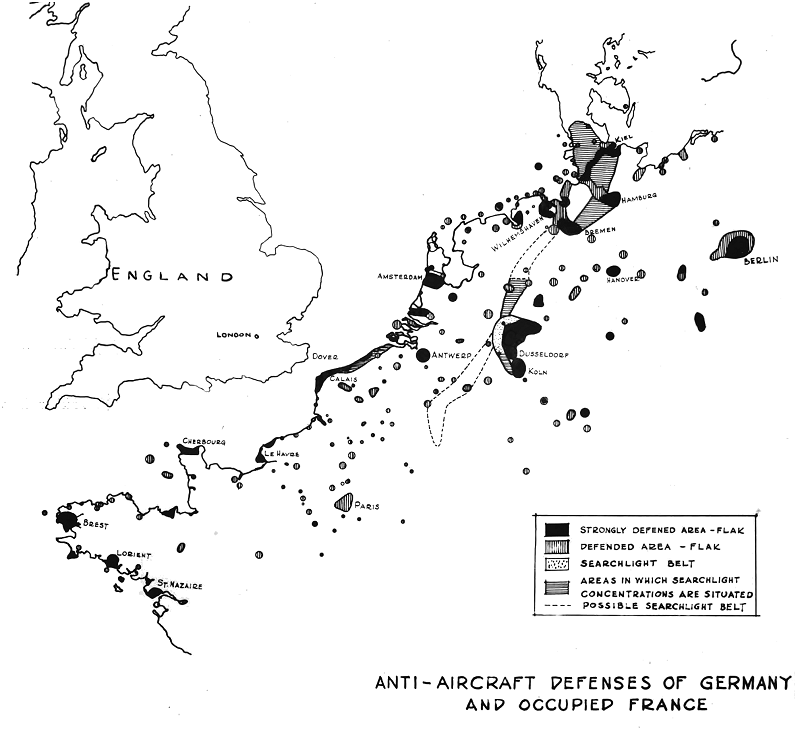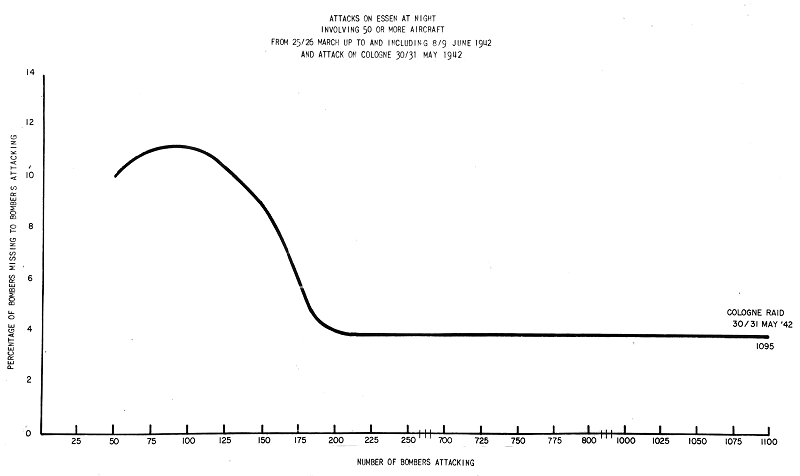PENETRATION OF ANTIAIRCRAFT DEFENSES
1. When the German Air Forces launched its daylight offensive
against Britain, the losses in bombers soon reached a prohibitive
rate. At the peak of this rate, the Germans actually lost 185
airplanes in one day. Apparently on the assumption that this rate
would continue and that the German air forces would be completely
depleted within a relatively short time, the German High Command
abandoned further prosecution of the daylight air offensive. This
erroneous assumption on the part of the Germans was extremely
fortunate for Great Britain, for at the time that the Germans
abandoned the daylight offensive the British fighter forces had
reached the point of exhaustion. A few more days of operation would
probably have seen the collapse of the British fighter defenses, and
the rate of attrition of the German forces would probably have
dropped to a negligible figure.
2. A similar experience may be anticipated in the penetration of
German fighter defenses by our own bombers, with one notable
exception. Our bombers have corrected the principal deficiency to be
found in the German bomber in 1940 – defensive fire power and
armor. Our heavy bombers are far superior in fire power and capacity
to absorb punishment to the bombers used by the Germans. Hence the
ratio of attrition between bombers and fighters has also been
radically altered. Our daylight penetrations of German defenses has
up to this time indicated a relatively low attrition rate to our
bombers and a relatively high attrition rate to German fighters.
Although these apparent rates may change in the future, nevertheless
the situation is radically different from that of September, 1940.
3. The Commanding General of the American Army Air Forces in Great
Britain has expressed the opinion that our current type bombers can
penetrate existing German defenses to the limit of their radius of
operation without excessive losses.
4. If we apply the same line of reasoning to our penetration of
German defenses as was used in the analysis of the German attempt
against Great Britain, we may reasonably expect a fairly high initial
rate of attrition of our forces, which will rapidly decline as the
German fighter forces become depleted.
5. The German fighter force at present on the Western Front is
estimated at 657 fighter aircraft. On the assumption that one of our
bombers would destroy two enemy fighters before itself being
destroyed, and that one German fighter is the equivalent of 1¼
American fighters (offensive action over enemy territory) it would
involve the loss of 325 of our bombers, or 820 of our fighters, to
destroy the present German fighter strength.
6. It is estimated that the number of German fighter aircraft that
would be available on the Western Front, if 75% of those now in
Russia were released for operations in Western Europe, is 1,200. On
the same assumptions outlined in paragraph 5, the neutralisation of
this fighter force might involve the loss of 600 of our bombers or
1,025 of our fighters.
7. Losses from antiaircraft fire will be negligible except at the
target if bombers keep at or above 25,000 feet. Best available
intelligence as to the location of German anti-aircraft artillery on
the Western Front is shown on the chart marked "Antiaircraft
Defense”. No figure is available as to the amount of German AA
Artillery on the Russian front, but it may be assumed that if
three-fourths of it were used to reinforce the antiaircraft defenses
of the Western Front it would be concentrated around targets which
already have some AAA defenses.
6. Another chart has been prepared showing what appears to be a
relationship between rate of attrition and size of penetrating force
for night bombing. This chart indicates that an attrition rate of
around 4% may be reached by a force of 200 or more bombers operating
at night and that the rate goes up materially as the force is
reduced. Attrition rate for day bombing cannot be estimated from this
table. Attrition for both day and night bombing will, however,
decrease as neutralization of enemy fighter aircraft takes place.
This decrease due to neutralization will be more pronounced in the
case of day bombing as the full effect of fighter aircraft cannot be
brought to bear at night.
9. CONCLUSION: Careful consideration of existing Radar, Fighter,
and Antiaircraft Artillery Defenses of Germany, together with the
best information available of the enemy’s air defense
capabilities, in the event of the withdrawal of 75% of the air
defense forces now engaged with Russia, leads to the conclusion that
the penetration of active air defense of the Axis' powers is
feasible, without, excessive losses. It is recognized that initial
losses may well be heavy and apparently prohibitive. This condition
will materially improve as the German Fighter Force is neutralized or
destroyed. Total losses should not exceed 300 bombers and 1,025
fighters.
– – – – – – –
– – – – – – – – –
– – – – – – – – –
– – – – – – – –
FIGHTER DEFENSE, RADAR LOCATIONS AND RADAR COVERAGE OF GERMANY AND
OCCUPIED FRANCE

– – – – – – –
– – – – – – – – –
– – – – – – – – –
– – – – – – – –
ANTI-AIRCRAFT DEFENSES OF GERMANY AND OCCUPIED FRANCE

– – – – – – –
– – – – – – – – –
– – – – – – – – –
– – – – – – – –
ATTACKS ON ESSEN AT NIGHT INVOLVING 50 OR MORE AIRCRAFT
FROM 25/26 MARCH UP TO AND INCLUDING 8/9 JUNE 1942 AND ATTACK ON COLOGNE 30/31 MAY 1942



